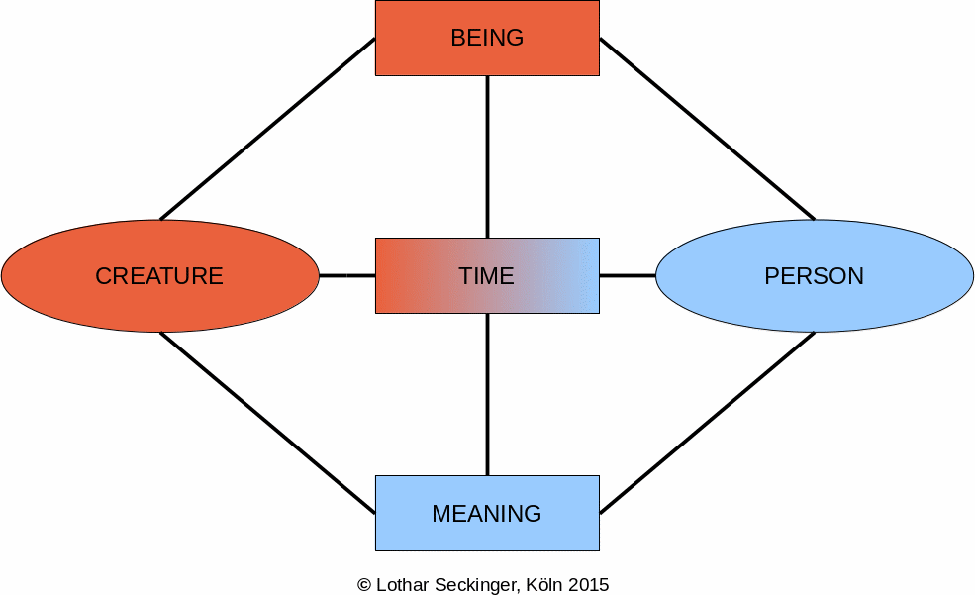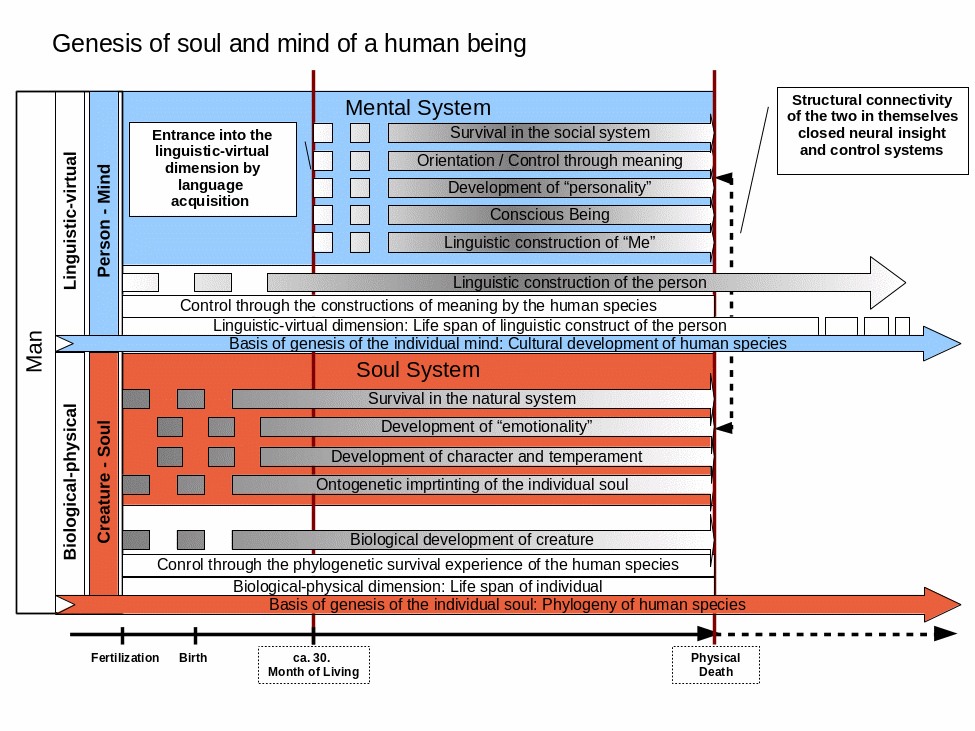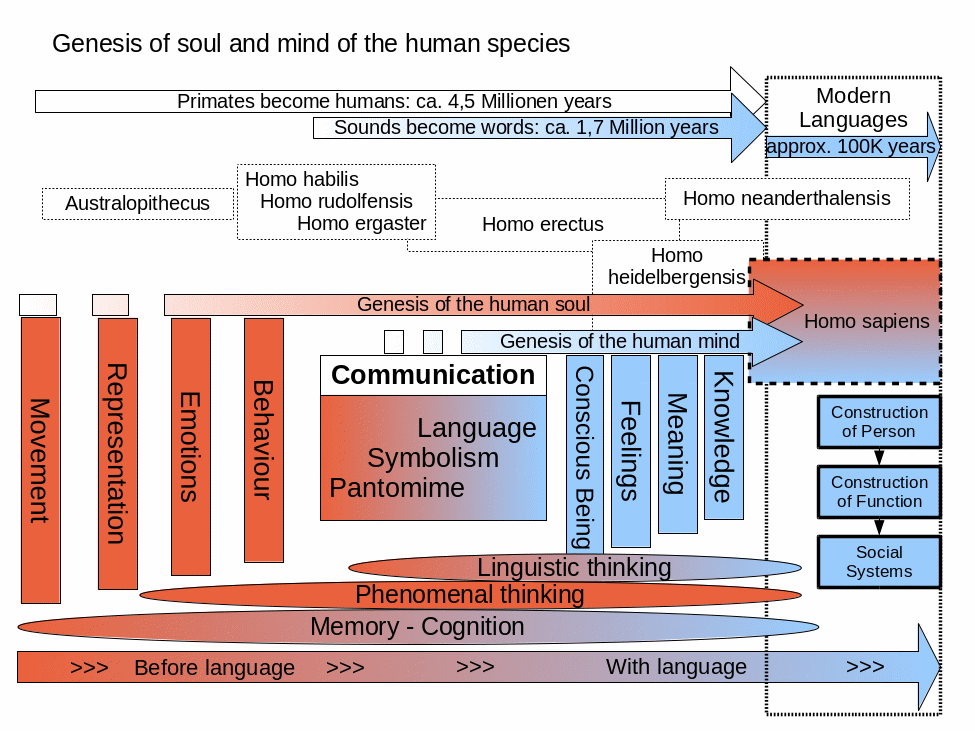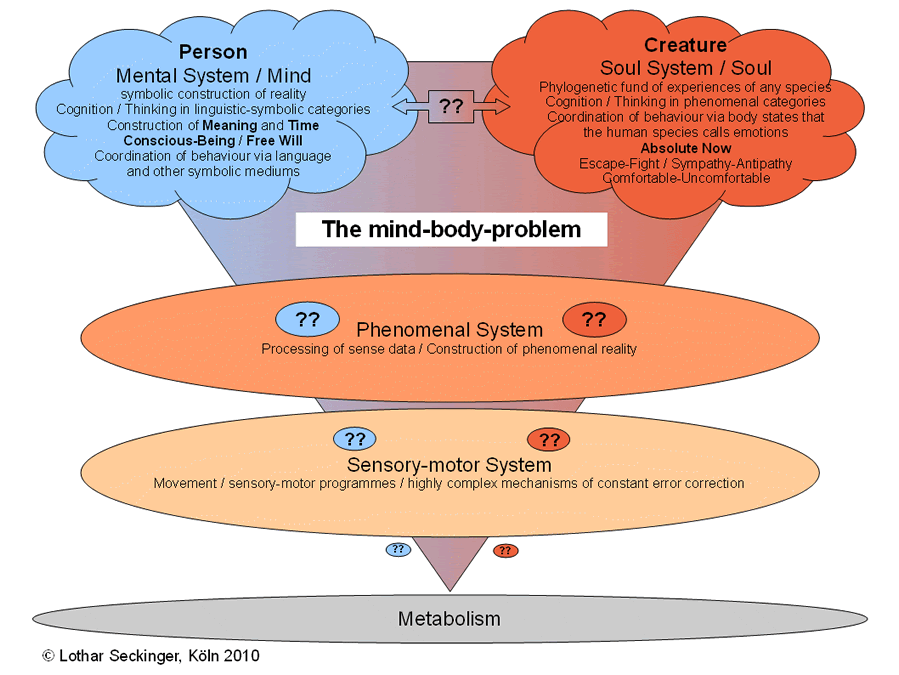The spark that ignited the from there on epigenetic driffen co-evolution of language and the human brain*
In retrospection, it must have been a truely magical moment, when presumably hominid creatures for the first time negotiated for the significance of a gesticular sign or oral sound and thereby constituted the first intersubjektive agreement about a communicative symbol.
This first intersubjective agreement about the significance of a symbol formed the foundation for the co-evolution of brain and language as described by Terrence Deacon. With this first intersubjective agreement, the symbolic depiction of the phenomenally perceived outer and inner bodily universe began. With each further agreement, each further intersubjectively agreed upon symbol, the participating creatures needed neural but also physiological capacities that didn't need any genetic mutation. Epigenetic processes and the adaptational capabilities of the brain to prevailing environmental and bodily requirements and conditions, as described by Terrence Deacon, were sufficient to drive the required adaptation of the hominid brain forward.
For the real cosmos had an enormous amount of objects and events at hand that were available for the intersubjective symbolic construction of meaning, a process that was especially enforced by the developing environmental conditions that our ancestors had to face.
With each further negotiation, each further agreement, each further intersubjectively added symbol and construction of meaning, the demands on the neural brain capacities and physiological oral-gesticular-auditory competences increased. Those symbols and constructions of meaning had to be processed, remembered, set into relationship to the former agreed upon ones, had to be made available for their usage in the upcoming expanding communicative dimension. A cyclical process began: with each further agreed upon symbol or construction of meaning, the required neural capacities expanded, with each expansion of linguistic-symbolic brain capacities, the potential for processing higher linguistic-symbolic complexity was provided.
But it all started with this magical moment of the first negotiation, the first agreement, the first intersubjectively created symbol and the first intersubjectively constituted construction of meaning.
Then, under the pressure of a changing habitat a devolopment was initiated by which the human species added a linguistic-symbolic dimension to the already existing real one.
This linguistic-symbolic dimension had a presumably strenuous start and at first expanded slowly and tenaciously. But a few ten thousand years ago this expansion accelerated and does so increasingly up to today.
In the meantime the human species has created a parallel linguistic-symbolic universe where it is in danger of loosing orientation and threatens to drown in its "pretended" puddle of knowledge.
* Terrence W. Deacon: The Symbolic Species, W.W.Norton and Company, New York - London, 1997
Since thousands of years was it a mystery: How could the purportedly "immaterial" mind have an effect on the obviously material world!
It has been overlooked that what we call the human mind never left the material world and always has been deeply rooted in the neural networks of the human brain.
What constitutes the human mind in the end, are definite material neural networks, where the intersubjektively agreed upon assignments of meaning are learned, created, stored, remembered and constructed by which sounds and signs become the medium of human communication. What appears as immaterial are only the symbols that are created by this process. However the neural basis that creates and consitutes these symbols in an intersubjective assignment of meaning, is undoubtedly of material nature.
Therefore, the human mind has always been deeply embedded in the neural networking and materially connected to all other neural networks of the human brain. No immaterial never had any effect on material substance, there always has been a direct material connection.
Thus, what seems to be immaterial concerning the human mind, the symbols created by the intersubjective assignment of meaning, have themselve a direct material basis in those neural networks that constitute these assignments.
There is no and never has been a gap between immaterial and material substances.

The physical-biological dimension is the dimension of creatures, wherein every living organism exists. This dimension knows no time and no meaning. Everything happens without any declared purpose or defined goal.
The symbolic-linguistic dimension is the dimension of personal constructs, to which only humans have access via language. Time and meaning only occur in this dimenson, as fundamental ingredients in the coordination of human behavior in the social systems of the human species.
We perceive these dimensions very much undifferentiated and completely intertwined. And therefore, it is very difficult for us, to differentiate between our existence as creature and person. But, in reality, these two dimensions are completely different manifestations of our human existence.
They seem so closely intertwined, because in our brain, they are represented in a way that we do not easily detect the fundamental differences. However, two autopoietic, self-referentially closed neural systems, only structurally interlinked, guide our behavior and define with great autonomy, what we perceive and constitute as essential.
We are creature and person, realising far to little, how much these two dimensions of our existence are differing from each other. The one is grounded in the overall cosmic dimension of being, the other in the purely symbolic dimension of the human language, and only as such in the shapes of time and meaning.
Would we only realize more that our being as creature ultimately determines our destiny, could we better align our being as person and regard and accept it as less important. Not what we represent as a person in the symbolic-linguistic dimension defines at last our wellbeing and happiness.
It is the state and fate of our being as a creature that ultimately and only matters.






It is, in every human brain, the gap between autopoietic, self-referential neural systems, where itself also constitutes what we call mind and soul.
For many centuries we might misinterpret something: It is not the human mind that feels, sees, smells, hears and experiences (for example pain) directly. The human mind only interprets what other neural, also self-referential systems reconstruct and represent out of inner and outer body states. In other words: The human mind sits in the second row of human perception and cognition. It can only interpret in linguistic-symbolic ways what is delivered by those neural networks that primarily represent inner bodily states and incoming signals from sense organs.
This would also explain, why the mind has no direct access to our perceptions and actions. It can only agitate in its closed self-referential linguistic-symbolic manner, and then induce, but not directly determine, what the surrounding networks that do determine bodily states and actions make of it.

Although tightly embraced, can they only perturb but not determine each other. In their dance, they try to interpret their mutual stirrings and strive to find a common strategy of survival for the creature wherein they exist.
Within the one, the phenomal system, constitutes itself the phenomenal reconstruction that tries to depict an as close as possible image of the interior and exterior environments of the human body. Therein reveals itself what we call the soul. This neural system organizes the strategy of survival of the unique ceature in biologic-physical contexts.
Within the other, the linguistic-symbolic system, constitute themself out of the phenomenal reconstructions of the former and based on the intersubjective assignment of significance to sounds and signs of the human languages symbolic interpretations of the interior and exterior envirenments of the human body. Therein reveals itself what we call the mind. This neural system organizes the strategy of survival of the multiple constructions of the person that the mind creates in the symbolic contexts of the human systems of language and society.
The dance of congnition is a tango of neural systems where the one can only interpret the stirrings of the other in its very unique way of perception. Tightly embraced, are they nevertheless separated, and can in a lifelong process only learn from each other, refer to each other, and in the best case approach each other.
That's it with soul and mind.
That's it from man do man.
That's it even from creature to creature, because animals also do have a phenomenal system within itself constitutes their soul, whose emotional signals enable mutual understanding and coordination of behavior across different species.
Conventional hard-earned wisdom from science and much of philosophy would have it that life has no meaning other than what we bring to it. It's completely up to us, even though the gnawing question always follows as to whether or not that really is the way it is.
Michael S. Gazzaniga
Peter Stemmer
We seemingly don't puzzle the meaning of life most of the time. We want to live life, not think about it.
Michael S. Gazzaniga
Therefore, is the phenomenon "time" eventually a virtual construct that only exists in the intersubjectvity of the linguistic-symbolic universe of the human species with no equivalent in the reality of the physical-biological cosmos?
If it were so, does the human being by thinking in language most of the "time" hover in symbolic spheres of its mind, where it doesn't exist physically?
And does the human being in the symbolic universe of its mind eventually miss most of the absolute NOW of the cosmic being, in which its body and soul exclusively dwell?
Radical novelty is almost impossible, and if we were to stumble upon it, it would take unusual strength and power to see anything of value in it. The challenge faced by an artist is to make something new that is comprehensible; to be comprehensible it must already be, in a way, at least partly, old. In fact, this is the quandary we face in every aspect of our lives.
To "boldly go where no man [or woman] has gone before", we must first travel to the limits of the known world.
Alva Noë
So did you, in the symbolic dimension of language, assign virtual concepts as kind, race, person, nationality, religion and property to the creature, while you forgot in just a few thousand years how little your natural needs fundamentally differ from each other.
So don't you recognize anymore that only the intersubjectively established and transgenerationally stabilized constructs of language lead to the differentiations that alienates you from the other and that you became an object in a linguistic-symbolic matrix where the other can mutate into a "mortal enemy".
It would be necessary that you more often recognize the creature behind the linguistic-symbolic construct, with whom you and your soul are more connected as your mind pretends.
This negotiability is the main difference to the significances of sounds or signs of animals. Those significances emerge from a phylogenetic process and are not negotiable. The significance of an animal sound or sign is fixed, can only be learned and only be changed by a transgenerational process of evolutionary adaptation, but not by a process of intersubjective agreement.
This process of intersubjective assignment is the main difference to symbols used by animals. Their significance is phylogenetically coded and stabilized and not negotiable among the communicating beings. It can only be changed by a transgenerational process of adaptation.
It was not the human language that emerged from the human mind. It was quite the opposite: only by the process of intersubjective assignment of significance, by which sounds and signs became words, could the human mind unfold itself in the developing transgenerationally stabilized neural-virtually constructed symbolic dimension of meaning of the human language.
This first intersubjective agreement about the significance of a symbol formed the foundation for the co-evolution of brain and language as described by Terrence Deacon. With this first intersubjective agreement, the symbolic depiction of the phenomenally perceived outer and inner bodily universe began. With each further agreement, each further intersubjectively agreed upon symbol, the participating creatures needed neural but also physiological capacities that didn't need any genetic mutation. Epigenetic processes and the adaptational capabilities of the brain to prevailing environmental and bodily requirements and conditions, as described by Terrence Deacon, were sufficient to drive the required adaptation of the hominid brain forward.
For the real cosmos had an enormous amount of objects and events at hand that were available for the intersubjective symbolic construction of meaning, a process that was especially enforced by the developing environmental conditions that our ancestors had to face.
With each further negotiation, each further agreement, each further intersubjectively added symbol and construction of meaning, the demands on the neural brain capacities and physiological oral-gesticular-auditory competences increased. Those symbols and constructions of meaning had to be processed, remembered, set into relationship to the former agreed upon ones, had to be made available for their usage in the upcoming expanding communicative dimension. A cyclical process began: with each further agreed upon symbol or construction of meaning, the required neural capacities expanded, with each expansion of linguistic-symbolic brain capacities, the potential for processing higher linguistic-symbolic complexity was provided.
But it all started with this magical moment of the first negotiation, the first agreement, the first intersubjectively created symbol and the first intersubjectively constituted construction of meaning.
Then, under the pressure of a changing habitat a devolopment was initiated by which the human species added a linguistic-symbolic dimension to the already existing real one. This linguistic-symbolic dimension had a presumably strenuous start and at first expanded slowly and tenaciously. But a few ten thousand years ago this expansion accelerated and does so increasingly up to today.
In the meantime the human species has created a parallel linguistic-symbolic universe where it is in danger of loosing orientation and threatens to drown in its "pretended" puddle of knowledge.
Since thousands of years was it a mystery: How could the purportedly "immaterial" mind have an effect on the obviously material world!
It has been overlooked that what we call the human mind never left the material world and always has been deeply rooted in the neural networks of the human brain.
What constitutes the human mind in the end, are definite material neural networks, where the intersubjektively agreed upon assignments of meaning are learned, created, stored, remembered and constructed by which sounds and signs become the medium of human communication. What appears as immaterial are only the symbols that are created by this process. However the neural basis that creates and consitutes these symbols in an intersubjective assignment of meaning, is undoubtedly of material nature.
Therefore, the human mind has always been deeply embedded in the neural networking and materially connected to all other neural networks of the human brain. No immaterial never had any effect on material substance, there always has been a direct material connection.
Thus, what seems to be immaterial concerning the human mind, the symbols created by the intersubjective assignment of meaning, have themselve a direct material basis in those neural networks that constitute these assignments.
There is no and never has been a gap between immaterial and material substances.
Er lebt nicht mehr in einem bloß physikalischen, sondern in einem symbolischen Universum
Ernst Cassirer
In a very literal sense, then, each developing brain region adapts to the body it finds itself in.
Human brains are not just large ape brains, they are ape brains with some rather sigificant alterations of proportions and relationships between the parts. We ought to expect a significant part of this shift in proportions to reflect adaptations to the unusual cognitive demand imposed by symbolic learning. In other words, if the human brain is a more language-friendly ape brain, then the special demands of the language adaptation are likely to be reflected in the ways that human brain structure diverges from nonhuman brain structure. Given the completely unprecedented and indeed countervailing demands imposed by symbolic learning, as contrasted to all other forms of learning, it seems inevitable that some equally unprecedented neuroanatomical changes must lie behind the human symoblic facility. The most extreme deviations in brain structure between human and other primate brains may thus offer clues to the neural computations that most distinguish human from nonhuman minds.
Symbol use itself must have been the prime mover for the prefrontalization of the brain in hominid evolution.
The remarkable expansion of the brain that took place in human evolution, and indirectly produced prefrontal expansion, was not the cause of symbolic language but a consequence of it.
Terrence W. Deacon
Indeed, neuroscientific evidence is now accumulating that experience-dependent brain activity in particular environmental contexts plays a huge role in the development of the individual brain. Rather than being a collection of prespecified modules, the brain appears to be an organ that constructs itself in development through spontaneously generated and experience-dependent activity (Quartz 1999; Quartz and Sejnowski 1997), a developmental process made possible by robust and flexible developmental mechanisms conserved in animal evolution.
Evan Thompson
The by the human brain phenomenally induced continuity of real states of being are interpreted and processed by the human mind in its symbolic dimension to a concept of duration that it calls "time". This concept of "time" is used to construct virtual pasts and futures that only exist in the symbolic dimension of language. The human mind doesn't realize that it only exists, embedded in the brain of the creature, in the absolute "NOW" of the cosmic genesis and that it succumbs to a self-produced "illusion of time".
The so-called "fourth" dimension is not a real, but a symbolic linguistic-medial dimension of the human species.
The concepts of "self" and "identity" are nothing else than virtual constructions of persons that the human mind self-creates in its linguistic-symbolic dimension. To be "self-conscious", as much as "consciousness", is the mode of the human mind by which it constitutes access to the linguistic-symbolic constructions of meaning of the human species and its function of behavioral coordination.
The problem of a "meaning of life" didn't turn up until the human species intersubjectively created the symbolic dimension of language. With the emerging linguistic-symbolic "consciousness" of its own existence the realization of the fact of death drove the in this virtual dimension rapidly expanding human mind to desperation. There had to be a "meaning of life", otherwise the whole purported misery of being would have short-circuited the self-oriented thinking. The ideas of myth, later gods and religion came up to calm down the emerging despair about the short and obviously mysterious phase of living.
"Meaning of life" in the virtual dimension of significance is a linguistic-symbolic feature invented by the human mind that cannot be deduced from the real cosmic dimension.
Only its linguistic-symbolic construct is more or less long reconstructed in those living brains that remember it or stumble across its medial relicts.
Wenn Symbole im Laufe ihrer Entwicklung einen sehr hohen Grad von Realitätsangemessenheit gewonnen haben, dann ist es für die Menschen zunächst oft besonders schwer, zwischen Symbol und Realität zu unterscheiden.
Norbert Elias

then came movement and with it cognition and perceiving inference of habitats,
then came emotional processes for transfer of survival knowledge and regulation of social behavior,
then came language and with it the symbolic universe that brought mind and consciousness about.
The neural and cellular networks that control these processes are operationally closed systems, i.e. they can perturb but not dominate each other.
Each system takes on its specific tasks and together they constitute the emergence of life.
Though we share the same earth with millions of kinds of living creatures, we also live in a world that no other species has access to. We inhabit a world full of abstractions, impossibilities, and paradoxes. We alone brood about what didn't happen, and spend a large part of each day musing about the way things could have been if events had transpired differently. And we alone ponder what it will be like not to be. In what other species could individuals ever be troubled by the fact that they do not recall the way things were before they were born and will not know what will occur after they die? We tell stories about our real experiences and invent stories about imagined ones, and we even make use of these stories to organize our lives. In a real sense, we live our lives in this shared virtual world. And slowly, over the millennia, we have come to realize that no other species on earth seems able to follow us into this miraculous place.
The doorway into this virtual world was opened to us alone by the evolution of language, because language is not merely a mode of communication, it is also the outward expression of an unusual mode of thought - symbolic representation.
Terrence W. Deacon
| English Version | German Version |